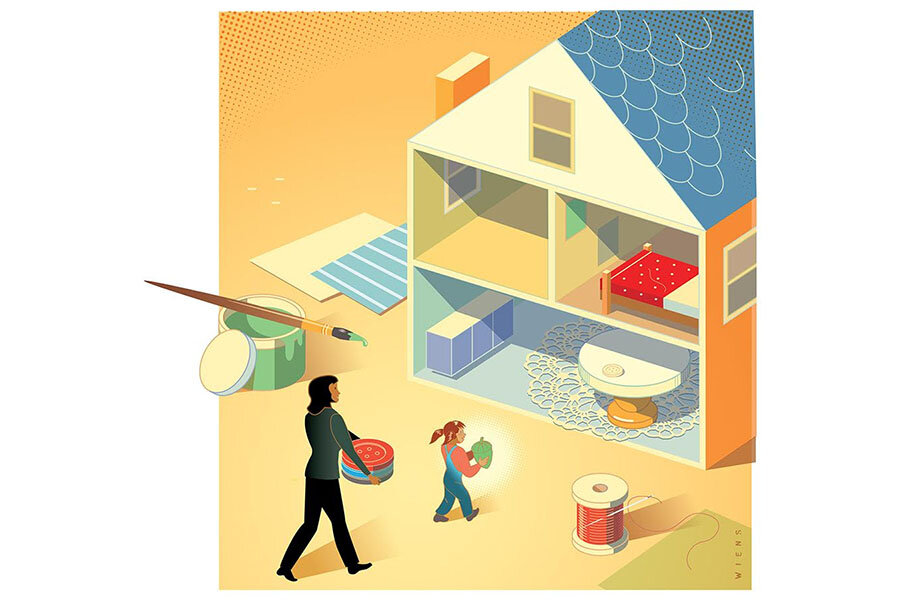Big lessons, learned on a small scale
My mother is taking a tour of the new house via Skype. I tilt the laptop so she can see where she’s going, pleased that our Internet connection in Zimbabwe is holding.
“This is the living room,” I say. Then I tell my daughter: “Show Grandma the bed for the mummy and the daddy.”
From a continent away, Grandma oohs and aahs her approval.
“Doesn’t that bedsheet look like that handkerchief I sent you a while back?” she asks.
“It is your handkerchief,” I say. I take apart the bed – a small children’s book made of cloth splayed out along its spine – and hold it up to the lens so Mum can see how her handkerchief tucks perfectly underneath.
Mum had a dollhouse, too. As a child growing up in eastern England, I was fascinated by her stories of her “house in a cookie tin.”
My grandmother, a feisty single mother who biked to work at a textile factory every day, did not have enough money to buy my mother a real dollhouse. So Mum made do, laboring over her square cookie tin for years. She stuck cutouts on the shiny walls: two beds from a catalog; tin cans of jam and bags of flour to make sure the dolls’ pantry was overflowing, even if her own mother’s wasn’t.
My mother passed her love of life in miniature on to me very early. At age 5, I made chests of drawers for my dollhouse bedroom from matchboxes glued together. Unused teabags swathed in cotton cloth became pillows. A rectangle of foam, painted brown and rolled tightly, was an inedible Swiss roll.
Unlike my mother, I was given some ready-made doll furniture and accessories. My favorites were the toffee-colored sofa and armchairs, and the red soda bottle complete with tiny trapped bubbles.
But much of my joy came from what I could cobble together with bits and pieces salvaged from the trash. My mother encouraged me, handing me thin slivers of soap for the dollhouse bathroom and always, always responding to my call: “Come see what I’ve made for my dollhouse!”
I spent hours writing a book with the unoriginal but certainly accurate title “How To Make Dolls’ House Furniture.” Each chapter dealt with a different room. The book was lost in a household move. But the satisfying feeling of filling up blank pages with my own ideas stayed with me, pushing me into a career centered on words and the trimming, rearranging, and counting of them.
My daughter turned 3 recently, and last month I put a sturdy empty cardboard box, about the size of a tea tray, in Cassia’s bedroom. We placed a plastic doily on the bottom of the box to make a carpet and balanced the lid from a plastic jar on top of an egg cup for a table.
I scoured the shops for dollhouse furniture. But an afternoon’s searching yielded only a pink plastic toilet and sink. It doesn’t matter, I told myself. It’s not as if I don’t know how to furnish a dollhouse.
I showed Cassia how to make plates for her table from colored buttons. Enthralled, she collected black stones and called them avocados. A plate of lumpy white “potatoes” soon appeared, fashioned from modeling paste.
A plug adapter is a perfect fridge. Acorns become oranges, stacked in a corner “in case the dolls get hungry.”
Now, when I find things lying about the house, I’ve learned to ask once again: “What can this be made into for the dollhouse?”
As I watch my child discover the fun of creating a miniature home, I think back to my mother and her cookie-tin house. What she gave me was much more than a fascination with things tiny: It was the ability to view things from a new perspective, to put oneself in another person’s (tiny) shoes, to solve problems with whatever is at hand.
This is what my mother taught me, and what her mother taught her. Now it’s my turn.
Cassia has found that the bridal veil from a bigger doll can become a mosquito net. A pile of fresh green clover is the dolls’ spinach, waiting to be chopped up for dinner.
Apart from saving empty spools and bits of dangly earrings, my job is mostly to marvel. And always, always to respond to the cry: “Come see what I’ve made for my dollhouse!”






